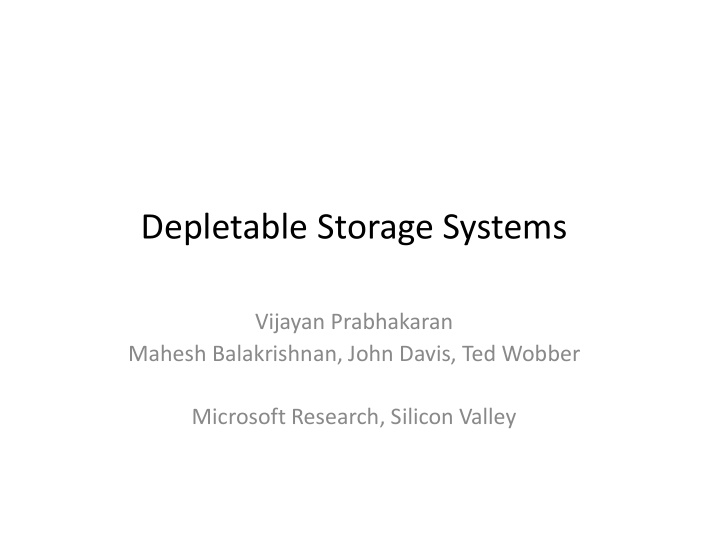



Depletable Storage Systems Vijayan Prabhakaran Mahesh Balakrishnan, John Davis, Ted Wobber Microsoft Research, Silicon Valley
Depletable Storage Systems • Traditional disk ‐ based storage systems – Space is the primary resource constraint – E.g.: Quota on file servers, pricing model in cloud • SSD ‐ based storage systems – Also, limited by number of erasures – Space and write cycles • Depletable storage systems – Limited lifetime – Measureable, predictable, relate to workload
Write ‐ lifetime of an SSD • Write ‐ lifetime – Amount of data written during SSD’s lifetime – Ideal: size x maximum erase cycles – E.g.: 80 GB x 5000 cycles = 400 TB • Write ‐ lifetime in practice – Affected by firmware inefficiencies – Write amplification – Cleaning and wear ‐ leveling
Write ‐ lifetime Metrics • SSD manufacturers address write ‐ lifetime • SanDisk’s Longterm Data Endurance (LDE) – Includes write amplification and wear ‐ leveling • Intel’s media wearout indicator – Percentage of lifetime left – “Decreases from 100 to 1 as average erase cycles used increases to the rated maximum”
Write ‐ lifetime Measurements Simple experiment • – Create a 70 GB file in Intel X25 ‐ M – Write certain size to a random offset
Depletion ‐ Aware Functionalities • Predictable device replacement based on lifetime – E.g., proactive RAID reconstruction • New pricing model – Charge users based on writes as well • New axis for comparison – Compare designs that reduce depletion • New attack models – Depletion of lifetime attack
New Mechanisms and Algorithms • Mechanisms – Track the writes – Attribute writes to appropriate applications – Control the writes • Depletion ‐ aware resource management – New scheduling algorithms
Challenges • Layers in software stack – VFS, caching, journaling, I/O schedulers, volume manager, software/hardware RAID, device – Impact writes: Delay, Amplify, Reduce • Media heterogeneity – MLC or SLC – Different price ‐ performance and erasure limits
Possible Solutions • Track, Attribute, and Control – VM to isolate applications and their writes – Cloud already uses VM for isolation • Beneath the VM – Minimize layers before issuing to SSD – Scheduling: allocate time quanta per VM [Argon] – May provide depletion isolation • Heterogeneity: write credit – Ideal write ‐ lifetime / price – Intel X25 ‐ M: (80GB x 5K erasures) / $220 = 1.78 TB per dollar – Intel X25 ‐ E: (64GB x 100K erasures)/ $745 = 8.59 TB per dollar
Conclusion • SSD Focus: performance, reliability, lifetime • Propose to treat SSDs as depletable storage systems • Need new mechanisms and algorithms to enable new functionalities
Recommend
More recommend